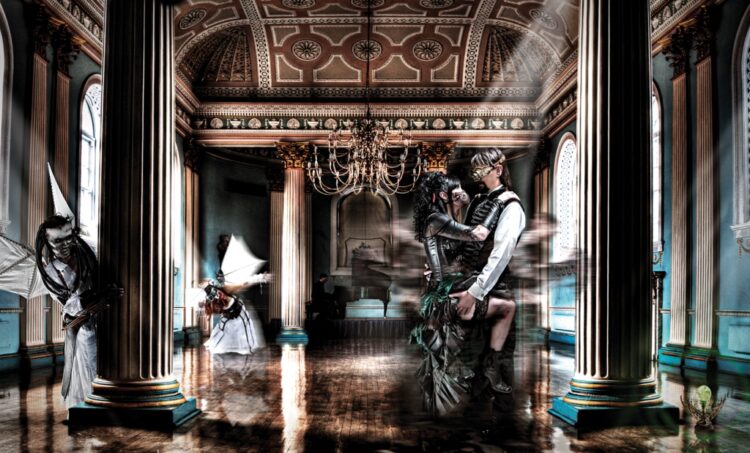Gary Nicholls, is one of the UK’s most respected steampunk photographers and authors whose work is gaining more and more attention with his limited edition book ‘The Imaginarium’.
G: Tell us how did the photography come into your life and how did you get into steampunk fine art?
G: My father taught me to draw as a young child, taking me to galleries and exhibitions from the age of 5. I was fascinated by the process or creating something amazing from imagination. I started using oils and watercolour then pen and ink drawings. I knew I wanted to be a creative I just struggled to be happy with how. It was not until I started using a digital camera and photoshop that I truly felt I had found my medium. I needed to unlock my imagination and after a chance visit to The Asylum, the world’s largest Steampunk festival in Lincoln, UK, I realised I had found my theme. Fantastic gadgets and amazing Victorian styling to the clothes means it is extremely stylish. It also allowed me to be very creative and dark for my story. There is an element of time travel in steampunk, which again allowed me to add a few modern day scenes, especially in what will be book two.
G: How do you come up with the storylines for your futuristic photoshoots, what’s your creative process?
G: The Imaginarium story is organic, it has evolved over 6 years. There were no auditions for parts. My one rule is that you have to be a genuine steampunk to be in the story. If I meet a Steampunk in an amazing costume the character will instantly form in my mind, including their whole back story. It is as though I have lived their characters life. The Steampunk community is amazingly creative and hugely inspiring, with no shortage of character possibilities, but it only works for me if I ‘see’ the character on first sight. I then work by asking the characters to act the scenes out, so I give them the back story and they then become the character I have in mind. Your inner vision is tuned to specific elements of art. You may like black and white, landscapes, portraits etc, but elements of all of these define your style. For me it is light. How Caravaggio used light to tell a story fascinated me and that is the approach I take to create my work, along with very detailed images, building up multiple layers in the same way that the old masters used oil. The ideas are, probably the easiest part of the process, I eat sleep and drink them. They come to me at odd times and I ‘see’ them completely finished in my mind’s eye. In order to find the setting I have ‘seen’, I search the internet for locations then travel there, wherever in the world that may be. The end result has to replicate the image I first ‘see’ for that picture, so researching the location has always been paramount. I might visit a place not for the place itself, but for a particular part or element of that place. I then shoot the subject in a studio in order to match and control the lighting. The images tend to generate the story, rather than the other way around.
G: The team comprises Julie Walton who gathers the threads from my imagination and uses those threads to make the costumes while putting her personal spin on them. The props are lovingly handcrafted by Julie’s husband Peter, an electrical engineer by trade, who built The Necessitti, around which the entire story is based. Peter also embellishes Julie’s costumes and has a huge influence on the story’s overall direction.
G: What kind of impact do you want to have with your art?
G: My style is a cinemagraphic one based on detail, from corner to corner of an image, ‘with an old masters’ look but a surreal feel. That style evolved through my workflow, trying new techniques and adapting them to create a look that I like, working layer after layer in the same way the old masters did, to create the image. The most satisfying moment is when a new piece is exhibited for the first time, but generally it is the people I meet while doing what I do that is priceless. In terms of impact, art is subjective, but printing on metal, as I do, means the final images have an amazing ‘wow’ factor, even if you don’t like the imagery, you cannot fail to see it.
G: What was your project that you enjoyed the most so far?
G: The Imaginarium is my main project, although I have also enjoyed a series called ‘Beauty in Decay’ with Burlesque dancers set in decaying building. However, with The Imaginarium being over 450 images, it takes up most of my time.
G: How would you describe the creative / art scene in East London?
G: March 1-3rd I am exhibiting at The Talented Art Fair at the Truman Brewery, it is an opportunity to see work by some of the best contemporary artists working today and that sums up the East London art scene for me – Diverse, creative and most of all exciting.
G: Who are your favourite artists?
G: All art by Caravaggio – the use of light just using a paintbrush is amazing and helps the viewer see the story he has created
Vermeer how his work represents light as a tangible substance, influenced the way I work.
H R Giger – his sculptures are thought provoking as are his paintings.
Jill Greenberg – American photographer and Pop artist influenced my work in the techniques she uses with both camera and photoshop.
Salvador Dali – his creative ideas were insane and an insight into his mind with his paintings being the epitome of Surrealism
Social links:
Website: www.g-n-p.co.uk and www.imaginariumtrilogy.co.uk
Instagram: @artimaginarium
Twitter: @artimaginarium
